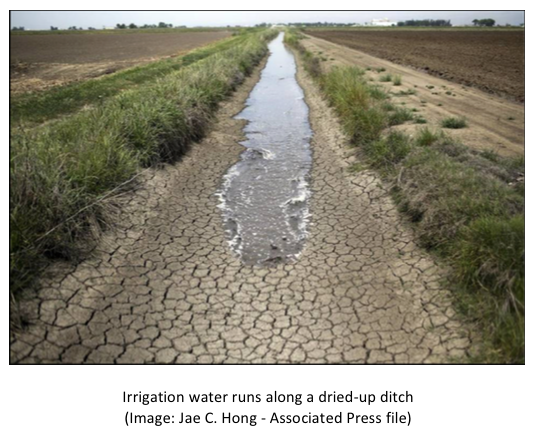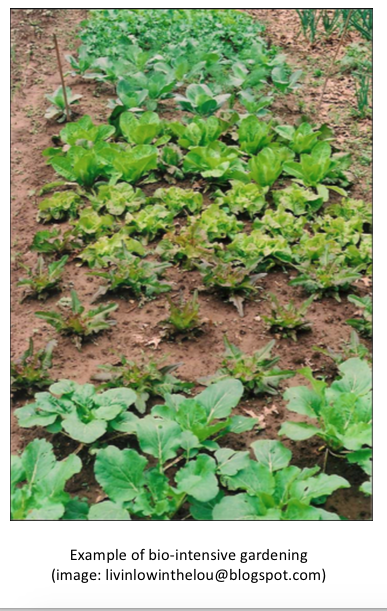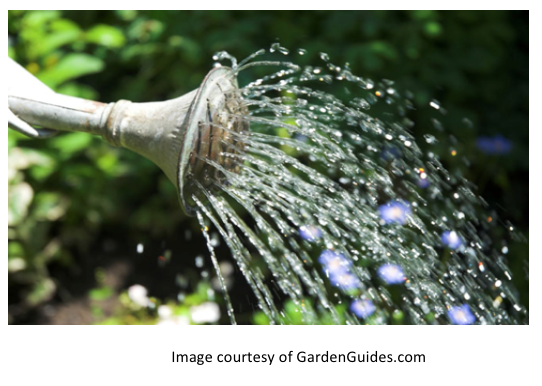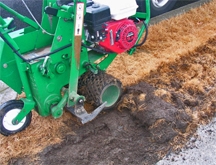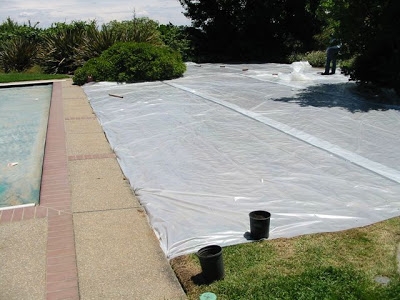From the UC Blogosphere...
UC Master Gardeners in LA are volunteers who garden
Instead of recruiting gardeners interested in volunteering, Yvonne Savio decided to look for volunteers interested in gardening. The subtle change led to development of a UC Master Gardener program in Los Angeles County that is unique in the state of California, reported Jeff Spurrier in the LA Times.
UC Master Gardeners volunteer under the auspices of UC Agriculture and Natural Resources (UC ANR). UC ANR Cooperative Extension offices in 50 California counties operate the volunteer gardening education program.
Savio has served as the UC Master Gardener coordinator in LA County since 1994. The first few years of MG classes, the students were often retirees or garden club members, many of whom were uninterested in volunteering in areas where they was the greatest need. In 2000, Savio visited community garden to search for volunteers.
"That's what started this synergy between master gardeners and community gardens," she says. "We in L.A. are completely different from other [master gardener programs] statewide in that we allow people to develop their own projects. We have had the special distinction in specializing in edibles, school gardens and low-income folks. As much as we're known for doing this wonderful stuff, it's not within the purview of other master gardener programs."
The program will continue after Savio retires at the end of June with Rachel Surls, the UC ANR Cooperative Extension urban agriculture advisor, at the helm. In retirement, Savio be writing a blog at http://gardeninginLA.net with garden resources for the greater Los Angeles County area and beyond.
Introducing the Latest in Dought-Friendly Landscaping -- Your Vegetable Garden!
Recently, a friend forwarded me a New York Times article about the nationwide use of California water through the consumption of food produced in the Golden State. The article, based on data from the University of California at Davis and the Pacific Institute, states that the average U.S. resident uses 300 gallons of California water this way, every week.
In the face of the worst drought in California recorded history, my inclination has been to stop growing water-thirsty annuals of any kind, including fruits and vegetables. Yet the Times article gave me pause; I feel confident that I can grow an asparagus tip using less than their stated .22 gallons of water and I most assuredly can grow an onion slice using less than .7 gallons!
Gardeners far wiser than I figured this out a long time ago. The phenomenal Rosalind Creasy - long a proponent of sustainable gardening - wrote a 2014 post on just this topic: “When in Drought – Plant Vegetables”. In her post, Rosalind states that growing the average pound of lettuce commercially uses 15 gallons of water, a pound of tomatoes 22 gallons, and a pound of potatoes 30 gallons. Bio-intensive gardener John Jeavons, Director of Ecology Action and author of the best-selling How to Grow More Vegetables, has demonstrated through years of hands-on research, that organic home gardening uses up to 87% less water to grow vegetables as compared to commercial farming. Contra Costa Master Gardener and journalist Joan Morris offers these additional tips for growing vegetables in a drought:
- Don't spare the compost. Add 3 to 4 inches of compost to your garden beds and work it lightly into the soil. Healthy soil produces healthy plants, which need less water.
- Mulch. Add 3 to 5 inches of mulch on top of beds to help reduce water evaporation. Mulch can be almost anything including dried leaves, aged horse manure, extra compost or straw, not hay. Mulch also will repress weed growth.
- Install a drip irrigation system. Drip systems use much less water than any other form of irrigation, and the plants like it better, too.
- Be selective. Plant only what you like and only as much as you'll consume.
- Consider planting early maturing and short-season crops, which will use less water.
- Plant seedlings close together on an offset pattern, rather than in a row. This configuration uses less water and as the plants grow, they will shade the soil and reduce evaporation.
- Grow high-yield vegetables, such as beans, squash, egg plant, peppers and tomatoes. You'll get more for your water buck with these plants.
- Keep your beds weeded. Weeds not only are annoying, they compete with your plants for water and nutrients, and they are much better at grabbing them.
- When given a choice, plant determinate varieties. Determinate plants grow to a certain size and produce for a specific amount of time. Indeterminate varieties will continue to grow and produce until frost. The determinate types, with their shorter growing season, will use less water.
- Instead of planting seeds and watering the entire bed, start seeds in a tray and then transplant the seedlings into your garden.
- We typically do this with certain plants, such as tomatoes, in order to get a head start on the growing season, but consider doing it with the big seed plants such as pumpkins, corn and squash.
- Use shade cloth to help prevent soil evaporation and prevent sunburn.
- Try dry farming. Many plants, including tomatoes, can be dry farmed. Our Garden will have two demonstration beds this year, growing a number of different tomato varieties.
- For successful dry farming, you want to create a spongy growing medium that will hold water. The best way, Miller says, is to grow a cover crop over the winter and then cut the plants down and work them into the soil.
- If you didn't have a cover crop, then prepare the bed with lots of compost.
- Plant your tomatoes and water them as usual for the first few days to get them established, then water only once a week. Once the tomatoes flower and set fruit, cut off all water. The plants may not look great, but they will produce and some say the fruit will taste better.
So step aside, all you salvias and succulents – my vegetable garden is coming through! My rudimentary rainwater and graywater systems will do their best to keep those veggies hydrated, lots of nutrient-rich compost and a deep layer of mulch will keep them cool and moist, and long, deep sips from a drip irrigation system will fill in as needed.
Happy Gardening!
For additional information on dry farming tomatoes, see http://ccmg.ucanr.edu/files/140321.pdf
Lawn Replacement Without Chemicals?
Client's Request to MGCC's Help Desk: Hopefully the Water District will soon approve my plans to replace the back yard lawn with a Zen rock garden utilizing black and white gravel. I have two small dogs so I don't want to use chemicals to kill the grass. Do you have suggestions to kill the grass that are pet friendly? I went to the rock supply business and they advised me to put some black material over the dirt to prevent weeds/grass from sprouting up. Should I dig up the grass or is there another way?
Advice From the MGCC's Help Desk: The current drought situation has motivated people such as yourself to replace their lawns with alternatives that use less water. Your idea of a Zen rock garden sounds like a wonderful option. There are several ways to remove lawn grass. The one you choose will depend on how large your lawn is, how much manual labor you want to invest, how much you want to spend, and how big of a hurry you are in.
Herbicide
Although you said that you have two small dogs and don't want to use chemicals to kill the grass, after considering the available options, you may want to reconsider ... of course following all required instructions and precautions. There are a number of herbicides that will kill lawn grass, but most are not substances that Master Gardeners would endorse using as your primary solution as they often leave residuals that carry too much risk of eventually ending up in runoff and/or problems with adjacent plants. Some herbicides, such as glyphosate (the active ingredient in widely available Roundup™), leave much less residual, but overspray can also damage adjacent vegetation. According to the manufacturer's label, Roundup is safe for pets and children to walk on after it has dried completely. However, you may not want your pets eating plants treated with glyphosate. According to the National Pesticide Information Center, pets that come in contact with wet glyphosate products may drool, have stomach upset, lose their appetite, or become sleepy. If you were to decide to use glyphosate, you should follow the manufacturer's instructions carefully.
Physical Removal
Removing sod doesn't work if you have a persistent perennial lawn grass like Bermuda grass – however it will work with Blue, Rye, and Fescue grasses. Simply removing the sod on Bermuda guarantees that it will be back, since the roots go down for several feet, and it only takes an inch of root to grow it all back. In this case, the only way to get rid of the lawn is through solarization or herbicides — plus several months of waiting to be sure it's really gone.
Solarization
Solarization is a slower (but efficient and inexpensive) method of removing a lawn. Technically, solarization is a method of soil sterilization using clear plastic, but a version, which might be called 'light exclusion' using black plastic, works for lawn removal. This method works best in areas with high summer temperatures, and should be done as spring is turning to summer. Cut the grass as short as possible and water well. Cover with large rolls of sturdy black polyethylene held in place by rocks or metal stakes. Cover the area, making sure it is airtight with no holes. The plastic sheets allow the sun's radiant energy to be trapped in the soil, heating the top 12 to 18 inches. When properly done, the top 6 inches of the soil will heat up to as high as 140°F, depending on the location. Leave in place for about 4 to 8 weeks (depending on how hot the weather is) until grass is dead. The high temperature may also kill some insects, plant diseases, nematodes and soil pathogens in the top layer of soil. Remove the plastic, and leave the dead grass to compost in place. This method also requires minimal labor and has minimal environmental impact. However, it takes a fair amount of time and must be done in hot weather only and is somewhat unsightly. And if you need to excavate for the gravel, physical removal may still be necessary.
Weed Block Fabric
Because you mentioned that you had applied to the Water District for a rebate, you will need to use a biodegradable weed block fabric because your Water District considers “non-biodegradable weed-block material” as a non-qualifying rebateable material. Your hardware or home center should be able to provide you with the specifications of their weed block material so that you can confirm that it is biodegradable.
For even more information on lawn removal see the U.C. website http://www.ipm.ucdavis.edu/TOOLS/TURF/RENOVATE/comremtrf.html.
Please feel free to contact us if you need more information.
Good luck on your lawn removal and Zen garden project.
Master Gardeners of Contra Costa Help Desk
Note: The Master Gardeners of Contra Costa's Help Desk is available year-round to answer your gardening questions. Except for a few holidays, we're open every week, Monday through Thursday for walk-ins from 9:00 am to Noon at 75 Santa Barbara Road, 2d Floor, Pleasant Hill, CA 94523. We can also be reached via telephone: (925) 646-6586, email: ccmg@ucanr.edu, or on the web at http://ccmg.ucanr.edu/Ask_Us/
Invasive Plants
Invasive Plants By Nancy Hartwick UCCE Master Gardener What makes a plant...
Daily Life For Master Gardeners
DIY Spaghetti Sauce By Andrea Peck One morning I woke up and just could not use spaghetti sauce in the jar. I'm...




